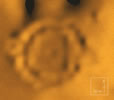
Huon Khim Circular Earthworks, Southeastern Cambodia
Until recently, the prehistory of Cambodian archaeology has been relatively neglected, due to the domination of interest in the Angkorean ruins. Most of the known prehistoric sites have been discovered by chance in the act of ploughing fields and laying out of plantations.
This slender base of Cambodian prehistory is slowly being broadened with new evidence of circular earthworks in the Kampong Cham province and the adjacent region of Vietnam. In the late 1950's. Louis Malleret described 17 circular earthworks with outer walls and inner ditches as a new category of prehistoric sites in the red soil region east of the Mekong River in the Kampong Cham province and adjacent Vietnam. Bernard Philippe Groslier excavated one of the circular earthworks near Memot, Cambodia in 1962, and defined the site as a previously unknown Neolithic cultural complex he called the Memotien. The sites have been interpreted as fortifications with palisades on the tops of mound walls, surrounding a circular ditch encircling a circular raised inner platform. Most of the discovered circular earthwork sites have been found on rubber plantations through word of mouth from local peasants and agricultural workers. Aerial photography has yielded some additional sites, but forest cover undoubtedly is hiding many more sites.
Recent attempts at dating these sites have been complicated by the fact that the acidic red clay soil has destroyed all organic evidence, as well as evidence of iron. Current attempts at dating the sites indicate the sites are remains of economical, rice agricultural, social, cultural and even political entity in the first millennium BCE, and that they are unlikely Neolithic fortifications.
The site modeled here is Huon Khim, with an outer diameter of c. 200 meters, and located 2 km north of the Kampoan Village, in southeastern Cambodia. The outer wall has semicircular extensions to the outside, and in this wider ditch, small mounds were found interpreted as piers for wood constructed bridges. Potsherds are rare, but many flaked adzes and stone blades (not debris of adze production) are found.
Elevation is 125 meters (410 feet) above sea level.
Construction: red clay soil earth mounding. Evidence of fiber-based architecture has been erased by the acidic soil.
Source of CG model data:
1. Albrecht, Gerd, Miriam Noel Haidle, Chhor Sivleng, Heang Leang Hong, Heng Sophady, Heng Than, Mao Someaphyvath, 2000; Circular Earthwork Krek 52/62: Recent Research on the Prehistory of Cambodia; Asian Perspectives 39
2. Dega, M. 2002. Prehistoric Circular Earthworks of Cambodia. BAR International Series 1041 Archaeopress Oxford.
3. Dega, M F 1999. Circular settlements within Eastern Cambodia. Indo-Pacific Prehistory Association Bulletin 18:181-190.
B_tmb.jpg)
H_tmb.jpg)
